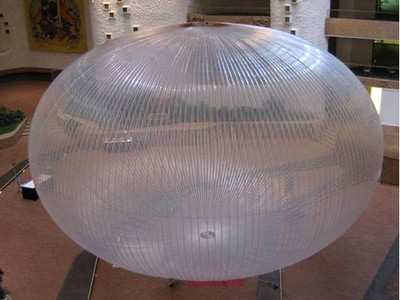Flying On The Very Edge Of Space
 Flying near the edge of space, a
NASA scientific balloon broke the flight record for duration and
distance. It soared for nearly 42 days, making three orbits around
the South Pole.
Flying near the edge of space, a
NASA scientific balloon broke the flight record for duration and
distance. It soared for nearly 42 days, making three orbits around
the South Pole.
The record-breaking balloon, almost as large as one and one half
football fields, carried the Cosmic Ray Energetics And Mass (CREAM)
experiment. CREAM is designed to explore the supernova acceleration
limit of cosmic rays, the relativistic gas of protons, electrons
and heavy nuclei arriving at Earth from outside the solar
system.
In addition to gathering scientific data, the flight was a
demonstration of the capabilities of the NASA Ultra-Long Duration
Balloon (ULDB) support system. The ULDB is being developed to
extend flights up to 100 days.
The pilot-less, helium-filled scientific balloon was launched
from the National Science Foundation's McMurdo Station, Antarctica
on Dec. 16, 2004. The balloon traveled 41 days and 22 hours. It
landed on January 27, 660 kilometers (410 miles) from McMurdo
Station. Payload recovery operations are in progress.
The previous endurance record for a balloon flight was in
December 2001 from McMurdo. The flight orbited the South Pole twice
over 31 days, 20 hours. The CREAM mission extended the continuous
science observation time over previous balloon missions.
"We are excited with the duration of this flight, which allowed
scientists to get ample data to perform their studies," said David
Pierce, Chief of the Balloon Program Office at NASA's Goddard Space
Flight Center's Wallops Flight Facility, Wallops Island, VA. "We
routinely have long duration balloons that float for up to two
weeks, but to have one flight last more than 41 days is very
rewarding," he added.
Scientific balloons are made of thin polyethylene material,
about the same thickness as ordinary sandwich wrap. An enormous
balloon was needed to hoist the two-ton CREAM experiment to about
38,100 meters (125,000 feet). NASA's balloon expanded to a diameter
of more than 137 meters (450 feet) and weighed 1,839 kilograms,
(4,055 pounds).
"Balloon-borne detectors, flying at the top of the atmosphere,
can identify incoming particles before they are broken up in
collisions with air nuclei," said Eun Suk Seo, the Principal
Investigator for CREAM at the University of Maryland, College Park,
MD. "The science instrument, support systems, and operation scheme
were successfully tested throughout this record breaking flight. We
are ready for a ULDB flight," Seo added.
"These state-of-the-art particle detectors were for the most
part built in university laboratories by students, young scientists
and engineers", said Dr. W. Vernon Jones, Senior Scientist for
Suborbital Research at NASA Headquarters. "Hands-on training while
conducting frontier research is a major strength of using balloons
for research," he said.

Personnel from the National Scientific Balloon Facility (NSBF),
Palestine, Texas annually support approximately 25 NASA balloon
flights from sites worldwide. They conducted the launch, flight,
and recovery operations of the CREAM balloon mission. "We are
really proud of our crew in Antarctica," said Danny Ball, Site
Manager of the Texas facility. "Everyone at NSBF contributed to
this success, but the crew that spent Thanksgiving, Christmas, and
New Years on the ice deserves most of the credit for a great
mission and yet another record flight," he added.
The National Science Foundation Office of Polar Programs
provided Antarctica ground and air operations support.
The CREAM experiment is collaboration among the University of
Maryland, the University of Chicago, Penn State University,
universities and organizations in Italy, Korea, France and Mexico.
Wallops manages NASA's Scientific Balloon Program for the Science
Mission Directorate, NASA Headquarters.
 ANN's Daily Aero-Linx (04.16.24)
ANN's Daily Aero-Linx (04.16.24) Aero-News: Quote of the Day (04.16.24)
Aero-News: Quote of the Day (04.16.24) Airborne 04.10.24: SnF24!, A50 Heritage Reveal, HeliCycle!, Montaer MC-01
Airborne 04.10.24: SnF24!, A50 Heritage Reveal, HeliCycle!, Montaer MC-01 Airborne 04.12.24: SnF24!, G100UL Is Here, Holy Micro, Plane Tags
Airborne 04.12.24: SnF24!, G100UL Is Here, Holy Micro, Plane Tags Airborne-Flight Training 04.17.24: Feds Need Controllers, Spirit Delay, Redbird
Airborne-Flight Training 04.17.24: Feds Need Controllers, Spirit Delay, Redbird




